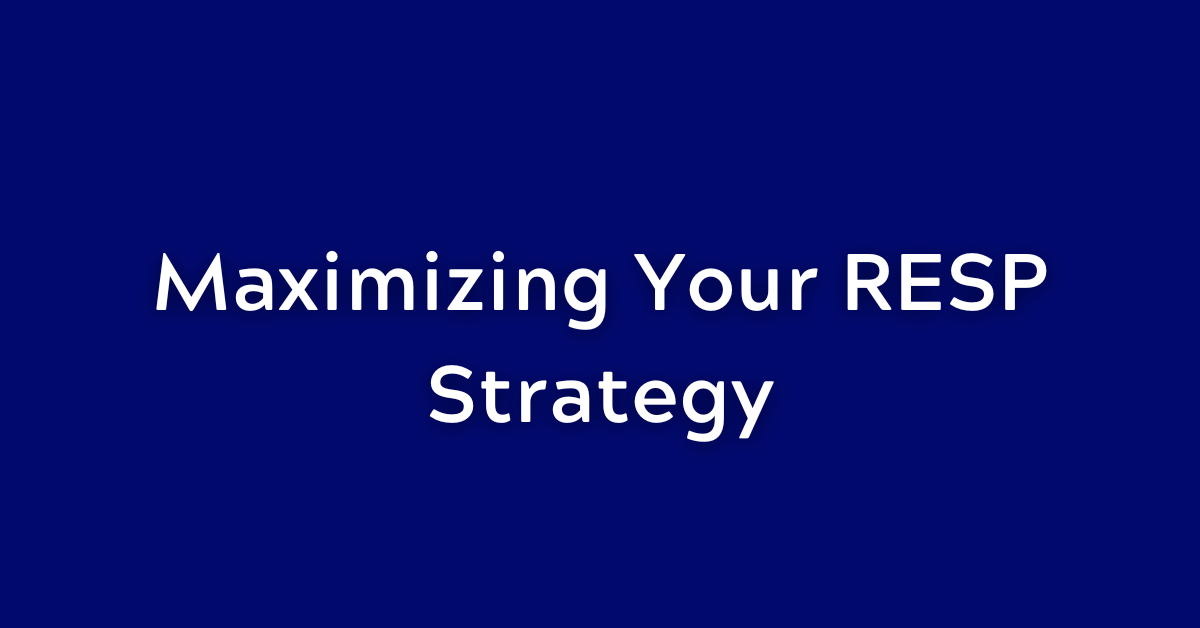 Registered Education Savings Plan (RESP)
Registered Education Savings Plan (RESP)
As the proud parent or guardian of a young one, you may have heard about RESPs (Registered Education Savings Plan) but wondered how they work and if they’re worth the investment. In this blog post, we’re breaking down RESPs in a way that’s easy for everyone to understand, regardless of your financial background.
What is a Registered Education Savings Plan (RESP)?
So, what exactly is an RESP? Think of it as a savings account with superpowers, specifically designed to help you save for your child’s education. The beauty of RESPs lies in their tax advantages and the grants– contributions grow tax-free until it’s time to use them for education-related expenses.
How can I maximize my RESP account?
The foundation of a successful RESP strategy lies in understanding the dynamics of contributions and government grants. Each beneficiary can receive a maximum of $500 per year in grants, or 20% of your contributions. To optimize your RESP, the target is to contribute $2,500 annually, resulting in a 20% match of $500. Contributing $2,500 from the day your beneficiary is born until they are 13 years old, and an additional $1,000 the following year will ensure the grant reaches its maximum limit of $7,200 (any amount over $7,200 must be repaid). By doing so, you’ll have contributed $36,000 to the RESP.
However, be mindful of the lifetime contribution limit of $50,000 per beneficiary. To optimize this, contribute an additional $14,000 in the year of their birth for tax-free compounding growth over 18+ years.
What are some RESP investing options?
RESPs aren’t just about saving; they’re also about growing your money. You can invest your contributions in various ways. Similar to RRSPs or TFSAs, RESPs can be invested in various assets like stocks, bonds, mutual funds, and ETFs. Optimize your investment strategy by starting with a low-cost diversified portfolio. Adjust the portfolio as your child gets older, transitioning to a more conservative approach to protect against market volatility before drawing funds for education. This flexibility allows you to choose an investment strategy that aligns with your comfort level and financial goals.
If you miss a contribution one year, that’s okay since you can make a catch up payment for any missed year. For example, if you missed contributing while your child was 3 years old, you could contribute $5000 in the next year and still receive $1000 in grants.
Canada Education Savings Grant (CESG)
One of the unique features of RESPs is the CESG, which matches your contributions up to a certain percentage. It’s essentially free money from the government to support your child’s education. Make sure you’re aware of the contribution limits to maximize your grant potential.
What are some RESP withdrawal options?
Understanding how to withdraw funds from a RESP is crucial. There are two withdrawal buckets – Post Secondary Education Withdrawals (PSE) and Education Assistance Payments (EAP).

- PSE withdrawals are tax-free and include your contributions.
- EAP withdrawals, taxable to the beneficiary, encompass grants and growth.
To make EAP withdrawals, the beneficiary must be enrolled in a qualifying educational program, which includes a broad range of options beyond traditional university or college courses. More information regarding school and program length eligibility can be found online, alongside a searchable list to find if your child’s chosen educational program qualifies for EAP.
If your child is in a low tax bracket, then taxable income won’t be too punitive.
Accumulated Income Payments (AIP)
Be cautious with Accumulated Income Payments (AIP), which may incur penalties. An example of an AIP scenario might be if the RESP has been open for 10 years, all beneficiaries are at least 21 years old, and they are not eligible for Education Assistance Payments (EAP). In this case, making an AIP withdrawal would involve paying back a prorated amount of the grants to the government, taxing the growth in the hands of the account opener, and applying an additional 20% penalty tax.
Can I transfer my RESP?
Some things usually don’t go as planned, that’s why the government has given you four viable options if the RESP funds are not utilized for education:
1) Keep the RESP Open for Future Studies: You can choose to maintain the RESP open, allowing the funds to continue growing tax-free. This option provides flexibility for the beneficiary to pursue education at a later date.
2) Replace the Beneficiary: If the original beneficiary decides not to pursue post-secondary education, you have the option to replace them with another eligible family member.
3) Transfer the Money to Other Registered Savings Plans: Alternatively, you can explore the option of transferring the accumulated funds to other registered savings plans, such as a RRSP or TFSA. This allows you to continue tax-advantaged growth in a different savings vehicle.
4) Close the RESP: If none of the above options align with your financial goals, you also have the choice to close the RESP. While this may incur tax implications on the accumulated income, it provides you with the flexibility to reallocate the funds.
So there you have it – Understanding the complete potential of utilizing RESPs can provide a significant advantage in saving money for educational costs. Mastering the art of optimizing contributions, managing investments, and strategically withdrawing funds is the key to unleashing the full potential of RESPs. Tailor your approach to your unique circumstances and remember to consult with a financial advisor to create a roadmap for your child’s educational journey.







